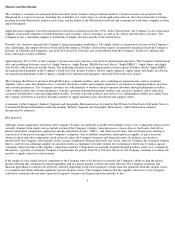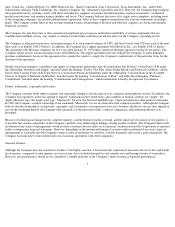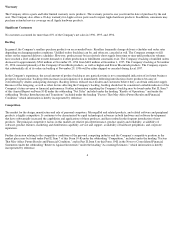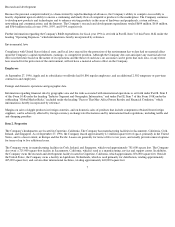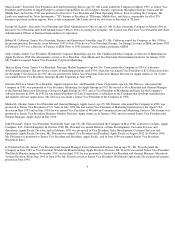Apple 1996 Annual Report Download - page 16
Download and view the complete annual report
Please find page 16 of the 1996 Apple annual report below. You can navigate through the pages in the report by either clicking on the pages listed below, or by using the keyword search tool below to find specific information within the annual report.Gross Margin
Gross margin represents the difference between the Company's net sales and its cost of goods sold. The amount of revenue generated by the
sale of products is influenced principally by the price set by the Company for its products relative to competitive products. The cost of goods
sold is based primarily on the cost of components and, to a lesser extent, direct labor costs. The type and cost of components included in
particular configurations of the Company's products (such as memory and disk drives) are often directly related to the need to market products
in configurations competitive with those of other manufacturers.
Competition in the personal computer industry is intense, and in the short term, frequent changes in pricing and product configuration are often
necessary in order to remain competitive. Accordingly, gross margin as a percentage of net sales can be significantly influenced in the short
term by actions undertaken by the Company in response to industrywide competitive pressures.
Gross margin decreased to 9.8% in 1996 compared with 25.8% in 1995. This decrease is primarily the result of a $616 million charge in the
second quarter of 1996 for the write-down of certain inventory, as well as the costs to cancel excess component orders, necessitated by
significantly lower than expected demand for many of the Company's products, primarily its entry-level products. Also, the Company
separately incurred approximately $145 million in charges during the last nine months of 1996 to provide for the estimated costs to correct
certain quality problems in certain entry-level, Performa, PowerBook and peripheral products, covering both goods held in inventory and
shipped goods. The Company also incurred greater warranty expenses per unit sold during 1996 compared with 1995. In addition, this decrease
in gross margins is due to the Company's response to extreme competitive actions by other companies attempting to gain market share,
including the Company's pricing actions in the United States, Japan and Europe across most product lines, which were partially offset by a
decrease in the cost of certain product components. In the first quarter of 1997, the Company took, and the Company expects that it will
continue to take, similar pricing actions with respect to a number of product lines.
The decrease in gross margin levels was slightly offset by hedging gains, net of the effects of a stronger U.S. dollar relative to certain foreign
currencies. The Company's operating and pricing strategies take into account changes in exchange rates over time; however, the Company's
results of operations can be significantly affected in the short term by fluctuations in foreign currency exchange rates.
Gross margin increased both in amount and as a percentage of net sales in 1995 compared with 1994. The increase in gross margin as a
percentage of net sales was primarily a result of a shift in product mix toward the Company's newer, high-margin products, which included
strong sales of certain products within the Company's Power Macintosh family of personal computers and its Macintosh Performa family. The
increase in gross margin levels was affected favorably by changes in foreign currency exchange rates as a result of a weaker U.S. dollar relative
to certain foreign currencies in 1995 compared with 1994.
Although gross margin for 1996 was 9.8%, it improved to 22.0% during the fourth quarter, primarily as a result of lower component costs,
sales of fully reserved product, and a shift in product mix toward the Company's newer products and products with multimedia configurations,
which tend to have higher margins. There can be no assurance that the Company will be able to sustain the gross margin level achieved in the
fourth quarter. Gross margins will remain under significant downward pressure due to a variety of factors, including continued industrywide
pricing pressures, increased competition, and compressed product life cycles. Gross margins could also be affected by the Company's ability to
effectively manage quality problems and warranty costs, and to stimulate demand for certain of its products.
Research and development expenditures decreased slightly in 1996 when compared with 1995, primarily due to the termination of certain third-
party joint development efforts. The increase as a percentage of net sales resulted from a decrease in the level of net sales. The increase in
research and development expenditures during 1995 compared with 1994 reflected higher project- and headcount-related spending. The
decrease as a percentage of net sales was the result of revenue growth in 1995 over 1994.
14
Research and Development 1996 Change 1995 Change 1994
Research and development $604 (2%) $614 9% $564
Percentage of net sales 6.1% 5.6% 6.1%


